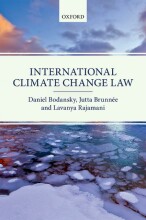Summary: International Climate Change Law | 9780199664290 | Daniel Bodansky, et al
- This + 400k other summaries
- A unique study and practice tool
- Never study anything twice again
- Get the grades you hope for
- 100% sure, 100% understanding
Read the summary and the most important questions on International Climate Change Law | 9780199664290 | Daniel Bodansky; Jutta Brunnée; Lavanya Rajamani
-
1 Introduction
-
1.1 Promotion of implementation and compliance
This is a preview. There are 2 more flashcards available for chapter 1.1
Show more cards here -
What are the compliance techniques of MEAs?
- Measurement, reporting and verification requirements have assumed great importance.
- Emergence of dedicated procedures and mechanisms to assess the parties’ compliance with their treaty commitments and provide fro a range of measures to facilitate or compel compliance. → MEA Non Compliance Procedures
- In line with teh managerial approach, MEA-based responses to non-compliance typically take account of the causes of non-compliance and of the differing circumstances of non complying states. → compliance committee: identifies the facts and possible causes relating to individual cases of non-compliance
- cooperative facilitation of compliance is the primary objective of many NCPs
-
How do the Kyoto protocol and Paris agreement differ in regards to compliance?
The kyoto protocol’s compliance procedure sets itself apart from other NCP’s by explicitly declaring its goals to be to facilitate, promote and enforce compliance. By contrast the Paris agreement reverts to a mechanism to facilitate implementation and promote compliance. -
2 Climate change as an intractable policy challenge
-
What is an intractable policy challenge?
This is a challenge that his been characterized as super wicked. Climate change is this because of it's planetary scale, long-term and potentially irreverible consequences, caused by a wide range of production and consumption processess, its causes and effects are global and require complex collective action, it can be managed if all states cooperate in undertaking potentially costly, large-scale shifts in their economic and energy systems -
3 Three perspectives on the Climate Change Problem
-
What are the three perspectives on climate change and where do they function?
- European countries have tended to see climate change as an environmental problem
- Many non-EU countries have tended to see climate change through an economic lense
- Many developing countries have tended to see climate change as part of a larger pattern of historical and economic injustices, so an ethical problem.
- European countries have tended to see climate change as an environmental problem
-
5 The subject matter of international climate chagne law
-
What are the four basic issues international climate change law focuses on?
- Mitigation of climate change -> limiting or preventing from happening
- adaptation to climate change -> in order to limit its harmful effects
- financial and other means of support for mitigation and adaptation
- international oversight to promote implementation, compliance , and effectiveness
- Mitigation of climate change -> limiting or preventing from happening
-
5.1 Mitigation
-
What does mitigation encompasses?
Both measures to limit GHG emissions (energy effiency standards and emission trading system) and measures to preserve or enhance sinks (land-use, reduce deforestation and degradation) -
5.2 Adaptation
This is a preview. There are 1 more flashcards available for chapter 5.2
Show more cards here -
What are the three basic rationales from adaptation?
- Since the biggest impacts of climate change will fall on states that contribute little to the problem, the coutries that are causing the problem should provide assistance.
- Countries most severely affected by climate change tend to be poor so international assistance is necesary to build their capacity.
- since the adaptation challenges faced by different countries are similar, states can learn from another by exchanging information.
- Since the biggest impacts of climate change will fall on states that contribute little to the problem, the coutries that are causing the problem should provide assistance.
-
5.3 Finance
-
How does finance finds it way in climate change?
Given the scale of resources required for mitigation and adaptation, and the arguable inequalities inherent in visiting costly mitigation and adaptation measures on developing countries, especially those with negligible emissions and capacity, the extent of support offered to these countries is key to adressing climate change -
5.4 Oversight
-
What type of mechanisms does international oversight promote?
Mechanisms to promote implementation, compliance and effectiveness, these can include national reporting on GHG emissions and on mitigation and adaptation measures. It can also involve expert review of information provided by states, mechanisms to assess implementation and compliance, reviews of effectiveness and formal dispute settlement. -
6 Treaty based lawmaking
-
6.1 what is a treaty
-
What is a treaty in the Vienna Convention on the law of treaties
An international agreement concluded between states in written from and governed by international law
- Higher grades + faster learning
- Never study anything twice
- 100% sure, 100% understanding
































